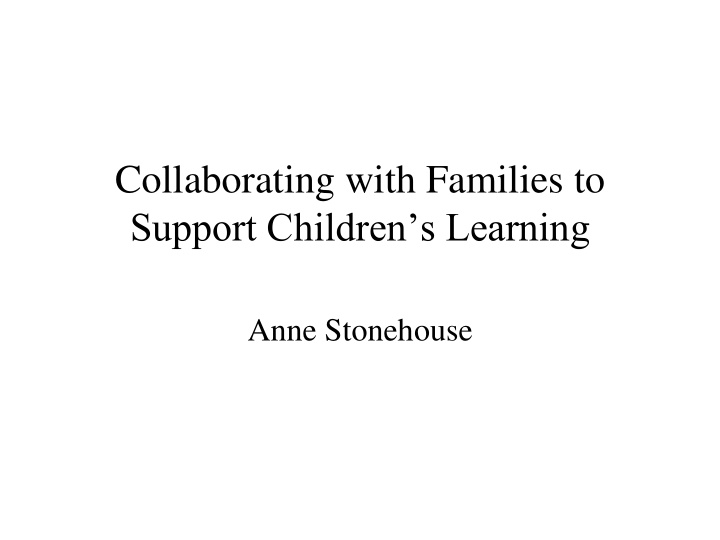



Collaborating with Families to Support Children’s Learning Anne Stonehouse
Goals/Purposes/Aims • What do you hope to achieve through your relationships with families? (in one sentence!)
• What might be some of the best times for a parent using your service?
• What might be some of the worst times for a parent using your service?
Sometimes we act as though children spring into being each morning when they come to us and dematerialize at their departure. We need, instead, to see children ‘whole’ as members of a family and a culture. (Warren, 1977, p8)
VEYLDF Practice Principle 1: Family-centred practice Why? • Children learn in families • Families are the primary influence on children’s learning and development – pivotal roles
EYLF Principle 2: Partnerships Why? • Helps to achieve Learning Outcomes • F amilies are children’s first and most influential teachers
VEYLDF Practice Principle 1: Family-centred practice What? • U se families’ understanding of their children • Make decisions together about a child’s learning and development • Create a welcoming and inclusive environment
VEYLDF Practice Principle 1: Family-centred practice What ? (continued) • Encourage all families to participate in and contribute to children’s experiences • Actively engage families and children in planning for children’s learning and development • P rovide feedback to families on their child’s learning and how they can support it
EYLF Principle 2: Partnerships What? • Create a welcoming environment • Respect & encourage collaboration • U nderstand each other’s expectations & attitudes • V alue each other’s knowledge
EYLF Principle 2: Partnerships What (continued)? • V alue each other’s contributions to and roles in child’s life • Trust • Communicate freely and respectfully • Share insights and perspectives • Engage in shared decision making
• The EYLF, VEYLDF and NQS advocate families, professionals and children teaching and learning from one another – not an expert model where professionals see themselves as experts whose role is to educate parents.
• We must communicate the message that families are children’s first and most influential teachers in ways that increase families’ confidence, joy and satisfaction in child rearing and that don’t add stress, especially for those families who already face significant pressures and stresses.
2 important points about learning: • Learning and development are not a race. What’s the point of pressuring children to learn things earlier than they would learn them without the pressure? • Practising ahead of time is not always the best way to prepare for the future.
• The large majority of families are doing the best they can in a world that is not always supportive. • There are many ways that families can nurture children’s love of learning.
Some characteristics of family- professional partnerships • Respect • S hared goals: the child’s wellbeing • Complementary contributions • Different perspectives
• What are some of the ways you show families that you respect them?
• A parent’s job is to be the President of their child’s fan club.
Why do partnerships matter? • Child’s identity • Child’s belonging to family • Foundation for learning: our relationship with the child • Source of our knowledge about the child • Continuity and consistency • Families’ belonging to communities
• What are the obstacles to partnerships with families? What gets in the way?
Some obstacles • Lack of time • Lack of confidence, skills, commitment • Biases and stereotypes • Cultural and language issues • Low expectations – ‘us & them’ attitude – general pre-disposition to be critical
More obstacles • Confusion with involvement and participation • License to educate • Tendency to blame the other • Child saving • Overlooking that parents are more than parents
• If you were going to stay for a long time with someone you didn’t know in a place you weren’t familiar with, what would make you feel welcomed?
Evidence of welcome – ‘Let me count the ways’ • What are the signs of welcome for all families in your service – in the physical environment and in your practice? • What more can you do and/or what can you do differently?
Practices that support partnerships • Set the stage from the first encounter • Multiple ways of communicating • G o beyond ‘show and tell’ to talk about why you do what you do • Talk about what the child is learning and has learned, not just what they are doing
More practices • Share all the good news you can • Adopt a ‘why not?’ rather than a ‘no way’ attitude • Ask – don’t presume to know • Be empathetic • Individualise expectations
• One of the most valuable things you can do for a child is to strengthen a sense of belonging to family, culture and community. • One of the most destructive is to diminish that sense of belonging.
• Family-professional partnerships, like most relationships, are built through a variety of seemingly insignificant, sometimes unconscious, interactions and interchanges over time.
• To look is one thing. To see what you look at is another. To understand what you see is a third. To learn from what you understand is still something else. But to act on what you learn is all that really matters. (Talmud)
• What is one step you can take tomorrow to strengthen your partnerships and collaboration with families and support children’s and families’ sense of belonging to each other?
Recommend
More recommend